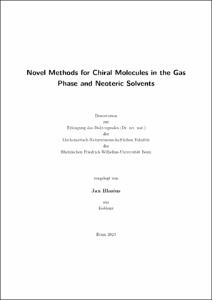Blasius, Jan: Novel Methods for Chiral Molecules in the Gas Phase and Neoteric Solvents. - Bonn, 2024. - Dissertation, Rheinische Friedrich-Wilhelms-Universität Bonn.
Online-Ausgabe in bonndoc: https://nbn-resolving.org/urn:nbn:de:hbz:5-74634
Online-Ausgabe in bonndoc: https://nbn-resolving.org/urn:nbn:de:hbz:5-74634
@phdthesis{handle:20.500.11811/11441,
urn: https://nbn-resolving.org/urn:nbn:de:hbz:5-74634,
doi: https://doi.org/10.48565/bonndoc-250,
author = {{Jan Blasius}},
title = {Novel Methods for Chiral Molecules in the Gas Phase and Neoteric Solvents},
school = {Rheinische Friedrich-Wilhelms-Universität Bonn},
year = 2024,
month = mar,
note = {This thesis focuses on the development and application of computational methods for the calculation of infrared (IR) and vibrational circular dichroism (VCD) spectra in the gas and liquid phase, with special emphasis on (non-idle) solvent effects. The solvents studied in this thesis are mainly alcohols and ionic liquids (ILs), and some of the methods presented are applied to study enantiomeric recognition and chirality transfer mechanisms in the latter.
The first part introduces the cluster-weighting (CW) approach for computing bulk phase vibrational spectra. This method is based on a weighted average of quantum-chemically calculated clusters, whose cluster populations are determined by quantum cluster equilibrium (QCE) calculations. Using two uncertainty propagation methods, it is shown that inaccuracies in experimental input data do not significantly affect the outcome of QCE calculations. CW is then used to calculate IR and VCD spectra of neat (R)-butan-2-ol and acetonitrile/(R)-butan-2-ol mixtures, yielding good to excellent agreement with experimental references. It is shown that structures up to hexamers are sufficient to reproduce the main features of the experimental liquid phase spectra, with the best agreement observed for clusters calculated at the BP86/def2-TZVP and B3LYP/def2-TZVP levels of theory. Another method based on ab initio molecular dynamics (AIMD) simulations is shown to yield spectra of higher quality, but at a significantly increased computational cost. Based on this, the computational efficiency of cluster-weighting is emphasized, especially for calculating mole fraction dependent spectral features (e.g., peak shifts) in mixtures.
In the second part, enantiomeric recognition and chirality transfer mechanisms in ILs are investigated by AIMD simulations. Dissolution of different D-glucose isomers in dry and moist 1-ethyl-3-methylimidazolium acetate causes chirality transfer from the glucose units to the transiently chiral cation of the IL, resulting in observable VCD activity of the latter. In addition, onsets for crystallization, anomeric conversion, and carbene-like reactions are observed, the understanding of which contributes to the development of new methods for processing glucose and cellulose. The importance of chirality transfer in chiral recognition mechanisms is emphasized by studying the dissolution of (R)- and (S)-butan-2-ol in 1-ethyl-3-methylimidazolium L-alaninate and (R)-1,2-propylene oxide in 1-ethyl-3-methylimidazolium bis(trifluoromethylsulfonyl)imide. While (R)-butan-2-ol and L-alaninate induce the same conformation in the cation, (S)-butan-2-ol induces a mirrored structure, causing an energetic destabilization. (R)-1,2-propylene oxide, on the other hand, is found to selectively transfer chirality to the bis(trifluoromethylsulfonyl)imide anion, leaving the cation unaffected. These findings provide a basis for future research into the targeted application of chirality transfer in enantiomeric recognition processes.},
url = {https://hdl.handle.net/20.500.11811/11441}
}
urn: https://nbn-resolving.org/urn:nbn:de:hbz:5-74634,
doi: https://doi.org/10.48565/bonndoc-250,
author = {{Jan Blasius}},
title = {Novel Methods for Chiral Molecules in the Gas Phase and Neoteric Solvents},
school = {Rheinische Friedrich-Wilhelms-Universität Bonn},
year = 2024,
month = mar,
note = {This thesis focuses on the development and application of computational methods for the calculation of infrared (IR) and vibrational circular dichroism (VCD) spectra in the gas and liquid phase, with special emphasis on (non-idle) solvent effects. The solvents studied in this thesis are mainly alcohols and ionic liquids (ILs), and some of the methods presented are applied to study enantiomeric recognition and chirality transfer mechanisms in the latter.
The first part introduces the cluster-weighting (CW) approach for computing bulk phase vibrational spectra. This method is based on a weighted average of quantum-chemically calculated clusters, whose cluster populations are determined by quantum cluster equilibrium (QCE) calculations. Using two uncertainty propagation methods, it is shown that inaccuracies in experimental input data do not significantly affect the outcome of QCE calculations. CW is then used to calculate IR and VCD spectra of neat (R)-butan-2-ol and acetonitrile/(R)-butan-2-ol mixtures, yielding good to excellent agreement with experimental references. It is shown that structures up to hexamers are sufficient to reproduce the main features of the experimental liquid phase spectra, with the best agreement observed for clusters calculated at the BP86/def2-TZVP and B3LYP/def2-TZVP levels of theory. Another method based on ab initio molecular dynamics (AIMD) simulations is shown to yield spectra of higher quality, but at a significantly increased computational cost. Based on this, the computational efficiency of cluster-weighting is emphasized, especially for calculating mole fraction dependent spectral features (e.g., peak shifts) in mixtures.
In the second part, enantiomeric recognition and chirality transfer mechanisms in ILs are investigated by AIMD simulations. Dissolution of different D-glucose isomers in dry and moist 1-ethyl-3-methylimidazolium acetate causes chirality transfer from the glucose units to the transiently chiral cation of the IL, resulting in observable VCD activity of the latter. In addition, onsets for crystallization, anomeric conversion, and carbene-like reactions are observed, the understanding of which contributes to the development of new methods for processing glucose and cellulose. The importance of chirality transfer in chiral recognition mechanisms is emphasized by studying the dissolution of (R)- and (S)-butan-2-ol in 1-ethyl-3-methylimidazolium L-alaninate and (R)-1,2-propylene oxide in 1-ethyl-3-methylimidazolium bis(trifluoromethylsulfonyl)imide. While (R)-butan-2-ol and L-alaninate induce the same conformation in the cation, (S)-butan-2-ol induces a mirrored structure, causing an energetic destabilization. (R)-1,2-propylene oxide, on the other hand, is found to selectively transfer chirality to the bis(trifluoromethylsulfonyl)imide anion, leaving the cation unaffected. These findings provide a basis for future research into the targeted application of chirality transfer in enantiomeric recognition processes.},
url = {https://hdl.handle.net/20.500.11811/11441}
}






